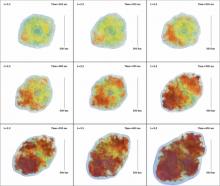
Abstract
A major goal over the last decade has been understanding which multidimensional effects are crucial in facilitating core-collapse supernova (CCSN) explosions. Unfortunately, much of this work has necessarily assumed axisymmetry. In this work, we present analyses of simplified two-dimensional (2D) and three-dimensional (3D) CCSN models with the goal of comparing the hydrodynamics in setups that differ only in dimension. Not surprisingly, we find many differences between 2D and 3D models. While some differences are subtle and perhaps not crucial, others are dramatic and make interpreting 2D models problematic. In particular, axisymmetric models produce excess power at the largest spatial scales, power that has been deemed critical in previous explosion models. Nevertheless, our 3D models, which have an order of magnitude less power than 2D models on large scales, explode earlier. Since explosions occur earlier in 3D than in 2D, the vigorous large-scale sloshing is either not critical in any dimension or the explosion mechanism operates differently in 2D and 3D. On the other hand, we find that the average parcel of matter in the gain region has been exposed to net heating for up to 30% longer in 3D than in 2D, an effect we attribute to the differing characters of turbulence in 2D and 3D. We suggest that this effect plays a prominent role in producing earlier explosions in 3D. Finally, we discuss a simple model for the runaway growth of buoyant bubbles that is able to quantitatively account for the growth of the shock radius and predicts a critical luminosity relation.